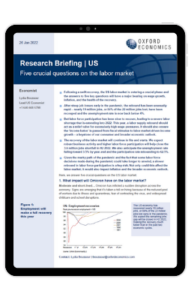Five crucial questions on the US labor market

Following a swift recovery, the US labor market is entering a crucial phase and the answers to five key questions will have a major bearing on wage growth, inflation, and the health of the recovery.
After steep job losses early in the pandemic, the rebound has been unusually rapid – nearly 19 million jobs, or 84% of the 22 million jobs lost, have been recouped and the unemployment rate is now back below 4%. But labor force participation has been slow to recover, leading to a severe labor shortage that is extending into 2022.
This year, a labor supply rebound should act as a relief valve for excessively high wage pressures. It should also ensure the ‘income baton’ is passed from fiscal stimulus to labor market-driven income growth – a keystone of our consumer and broader economic outlook.
The recovery of the labor market will continue in fits and starts. We expect robust business activity and higher labor force participation will help close the 3.6 million jobs shortfall in H2 2022. We also anticipate the unemployment rate falling toward 3.5% by year-end and the participation rate rebounding to 62.5%.
Given the murky path of the pandemic and the fact that some labor force decisions made during the pandemic could take longer to unwind, a slower rebound in labor force participation is a key risk. Not only could this affect the labor market; it would also impact inflation and the broader economic outlook.
Read the report for full answers to the five crucial questions on the US labor market:
- What impact will Omicron have on the labor market?
- How tight is the labor market?
- Will labor force participation rebound?
- Will wage growth stay hot?
- How close are we to ‘full employment’?
Tags:
Related Research

Post
House prices continue to slide for China’s cities
Research Briefing Five crucial questions on the US labor market While the property market downturn has been universal, the scale and depth has been varied for different cities and regions.
Find Out More
Post
The Construction Productivity Challenge in Australia
Delve into the state of construction productivity in Australia. Understand the factors affecting growth and how innovation can transform the industry for the better.
Find Out More
Post
Australia’s future outlook: Net overseas migration trends
Australia’s student migration slowed in FY2025 as higher fees, testing standards, and provider caps took effect. While net overseas migration eased to 280,000, favourable currency settings, stronger work rights, and a higher student cap signal modest growth opportunities ahead.
Find Out More